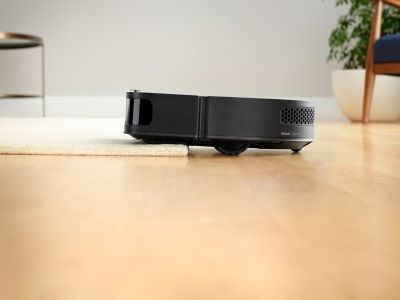iRobot (IRBT -0.73%) reported strong fourth-quarter 2020 results after the market close on Wednesday.
Shares soared 9.1% in Wednesday's after-hours trading. We can attribute the market's enthusiasm in part to the maker of home-cleaning robots speeding by Wall Street's fourth-quarter consensus revenue and earnings estimates. Another factor was surely that full-year 2021 guidance for both the top and bottom lines came in higher than analysts had been expecting.
Here's an overview of the consumer-technology company's quarter, along with its guidance.

Roomba s9. Image source: iRobot.
1. Revenue jumped 28%
Net quarterly sales rose 28% year over year to $544.8 million, breezing by the $494.1 million Wall Street had expected.
In Q4, domestic sales rose 28% year over year to $316.3 million, and international sales grew 27% to $228.6 million. Sales of Roomba robotic vacuums accounted for 89% of total revenue, with sales of Braava robotic mops generating the remaining 11%. Average gross selling price for a robotic unit edged up to $317 from $310 in the year-ago period.
For full-year 2020, iRobot's revenue increased 18% year over year to $1.43 billion. This percentage growth slightly overstates the company's underlying performance in 2020 because the year included 53 weeks, while the prior year included only 52 weeks. Nonetheless, revenue growth was still very solid.
2. Adjusted operating income rose 13%
Adjusted for one-time items, operating income increased by 13% year over year to $30.4 million. On the basis of generally accepted accounting principles (GAAP), operating profit fell 8% year over year.
3. Adjusted EPS surged 22%
Adjusted net income rose 23% year over year to $24.2 million, which translated to earnings per share (EPS) surging by 22% to $0.84. Wall Street was only expecting adjusted EPS of $0.31. GAAP EPS declined to $0.46 from $0.70 in the year-ago period.
4. Cash on hand soared 89%
iRobot is in good shape to fund its growth initiatives. It ended the period with $483.7 million in cash, cash equivalents, and short-term investments, up 89% year over year. It has just under $78 million in long-term liabilities.
The cash-position growth was driven by cash generated from operations in 2020 surging 78% year over year to $232 million.
5. Full-year 2021 revenue is expected to grow about 14% to 17%
For full-year 2021, management guided for net sales in the range of $1.635 billion to $1.675 billion, which would represent year-over-year growth of about 14% to 17%. This entire range exceeded Wall Street's consensus estimate of $1.47 billion.
The company also expects that its 2021 adjusted EPS will be between $3.00 and $3.25, down from $4.14 in 2020. Going into the release, analysts had been modeling for adjusted EPS of $2.19, so iRobot's earnings outlook is considerably brighter than expected.
In the earnings release, CEO Colin Angle commented on the company's 2021 guidance and general expectations for 2022:
Our outlook for 2021 reflects our confidence that the growth drivers for our business will remain largely intact over the coming quarters. We believe that our success in continuing to drive solid top-line expansion in 2021 will also enable us to fund investment into key areas of our business and help mitigate the impact of tariffs on our 2021 profitability. ... As we continue to execute on our plans, we are excited about our prospects to sustain solid top-line growth into 2022 and convert that expansion into 2022 profit margins and EPS that exceed 2020 levels.
As to tariffs, the company anticipates tariffs on its products made in China and imported into the United States to be a headwind to profitability in 2021. In 2020, it received a tariff exclusion, resulting in it receiving refunds of tariffs it had paid during the year. In 2022, management expects the tariff headwind to significantly subside because it anticipates transitioning much manufacturing to Malaysia in 2021.





